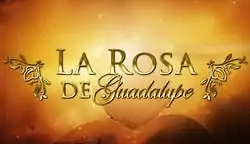La rosa de Guadalupe
La Rosa de Guadalupe (English title: The Rose of Guadalupe) is a Mexican anthology drama television series created by Carlos Mercado Orduña that premiered on Las Estrellas on February 5, 2008. It is produced by Miguel Ángel Herros. The series centers on the Mexican people's relationship to the Catholic religion, specifically to the Nuestra Señora de Guadalupe. It is set in modern times, most often in Mexico City, but the location may vary in some episodes. In the United States the series premiered on June 26, 2008[1] and runs on Univision.[2]
| La Rosa de Guadalupe | |
|---|---|
 | |
| Genre | Melodrama Drama |
| Created by | Carlos Mercado Orduña |
| Written by | Julián Aguilar Carlos Mercado Mauricio Aridjis Fabián Quezada |
| Directed by | José Ángel García Marta Luna Ricardo de la Parra Eduardo Said Lorena Maza |
| Presented by | Helena Rojo |
| Opening theme | Instrumental theme |
| Country of origin | Mexico |
| Original language | Spanish |
| No. of seasons | 13 |
| No. of episodes | 1,500+ |
| Production | |
| Executive producer | Miguel Angel Herros |
| Production locations |
|
| Camera setup | Multi-camera |
| Running time | 41-44 minutes |
| Production company | Televisa |
| Distributor | Televisa International |
| Release | |
| Original network | Las Estrellas |
| Picture format | 1080i (16:9 HDTV) |
| Audio format | Stereophonic sound |
| Original release | February 5, 2008 – present |
| External links | |
| Website | |
Plot
There are two types of beginnings for the episodes: a happy beginning, or a more melodramatic beginning where the main character undergoes a calamitous event that kickstarts their development. In the latter, the editor, cast, and director's credits roll during the second scene.
Main characters, being extremely devout to the Virgin of Guadalupe, almost always ask her to protect them. At the same time, a white rose appears before an altar or statue of the Virgin that belongs to the person who prayed or is in trouble, and remains there during the development of the story, which usually sees an escalation of the problem. The rose's appearance means that the petition has been heard by the Virgin.
At the climax of the story, the closest person "asked" by the Virgin intercedes for the main character and tries to help. When the issue is resolved, the main character is "touched" by a wind that represents the act of the Virgin of Guadalupe, and at the end of the episode, the white rose disappears as a character narrates the message of the episode.
History
"Las mil rosas" ("The Thousand Roses")
On July 5, 2017, the series began its 1,000th episode celebration. Remastered versions of the earliest episodes from 2008 to 2016 were aired beginning July 10, 2017. On July 22, 2017, the 1,000th episode, "The Bastard Sister", was aired. Alejandra Barros and Alexis Ayala starred in the episode.[3]
Impact stories
Starting in May 2017, "La rosa de Guadalupe" began broadcasting episodes with more serious, social issue-driven "impact" stories on Saturdays at 9:30 pm. These stories featured more explicit topics such as rape, incest, sexual harassment, murder, and drug addiction. The content rating given to these Saturday night episodes is B-15, whereas the content rating of episodes broadcast during the business week is B.[4]
Reception
The show has been panned by Mexican viewers and critics for its lack of proper acting, writing, and directing. Some talk shows have criticized the low-fidelity effects and poor acting, as well as the lack of research for episodes dealing with certain social groups or issues such as bullying, family problems, and even sexual abuse.
La rosa de Guadalupe is considered the most controversial series Televisa has ever transmitted throughout Latin America, constantly subjected to criticism since its first broadcast.[5] It consistently portrays children and adolescents as antagonists. It is also criticized for insinuating that society's problems are only resolved through prayers and divine intervention and for presenting an exaggerated reality about Catholics, in addition to casting young actors with poor performances.[6] Nonetheless, the controversy has brought a sizable amount of attention to the series and created a cult following online, where it is viewed as a source of accidental comedy.
Websites
La rosa de Guadalupe has been mocked on social networks such as Facebook, where they often make memes that make fun of the episodes and their characters; also YouTube users have mocked the episodes and even performed parodies. Within the same Televisa, several comedians have also made fun of the series, within sketches of different comedy programs.
References
- "Univision presents 'La Rosa de Guadalupe'". hispanicad.com. Retrieved 15 March 2019.
- "La Rosa de Guadalupe", Univision website, retrieved January 1, 2021
- "'La Rosa de Guadalupe' Mil capítulos, mil historias de lucha y esperanza". Televisa.com (in Spanish). Retrieved 21 August 2017.
- "Este sábado: ¡No te pierdas La rosa de Guadalupe, relatos de impacto!". lasestrellas.tv (in Spanish). Retrieved 21 August 2017.
- "Yo escribo 'La Rosa de Guadalupe'" (in Spanish). Chilango. 5 September 2015. Retrieved 5 July 2017.
Ha sido una serie muy criticada desde que empezó, sobre todo por el uso de los elementos mágicos de la rosa y el viento.
- "Cuatro razones de por qué La Rosa de Guadalupe es un éxito en nuestro país" (in Spanish). Radio Panamericana. 23 September 2015. Retrieved 5 July 2017.